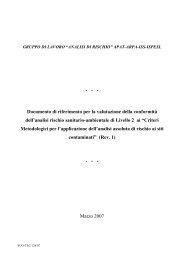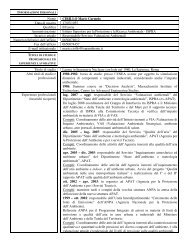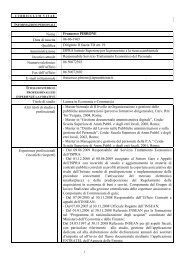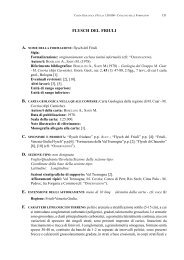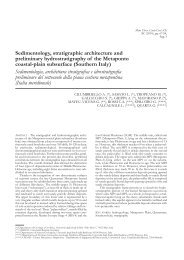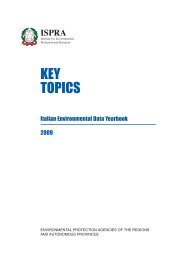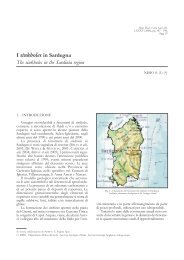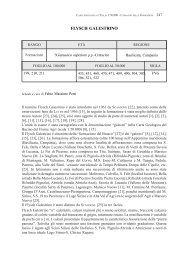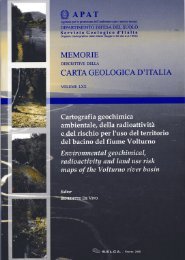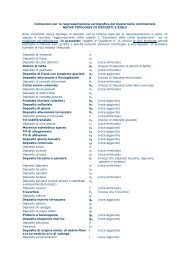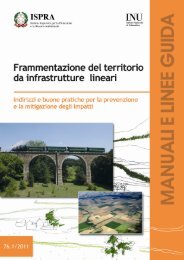Guidebook - Ispra
Guidebook - Ispra
Guidebook - Ispra
Create successful ePaper yourself
Turn your PDF publications into a flip-book with our unique Google optimized e-Paper software.
THE APULIA CARBONATE PLATFORM-MARGIN AND SLOPE, LATE JURASSIC TO<br />
EOCENE OF THE MAIELLA MT. AND GARGANO PROMONTORY:<br />
PHYSICAL STRATIGRAPHY AND ARCHITECTURE P18<br />
separating a structural depression, where the Molise<br />
Allocthonous Units crop-out (Figs.1 and 4).<br />
The sedimentary succession of the Maiella records the<br />
complete geodynamic evolution from the late stages of<br />
the Tethyan post-rift (Early Cretaceous) to the stress<br />
inversion that precedes the closure of the western<br />
Alpine Tethys (Late Cretaceous-Early Tertiary), up to<br />
the fi nal stages of the building process of the Central<br />
Apenninic chain (Pliocene-Pleistocene).<br />
The Cretaceous stratigraphic units represent different<br />
depositional environments: the inner platform, in<br />
the southern and central areas, the slope and basin<br />
in the northern sectors. The Cretaceous sedimentary<br />
evolution of the Maiella is characterized by the<br />
transition between an escarpment-bounded platform<br />
to a carbonate ramp. During the Tertiary, depositional<br />
conditions were more homogeneous and dominated<br />
by carbonate ramps until the early Messinian. Starting<br />
from the late Messinian, concomitantly with the<br />
evaporitic event, the Maiella and the surrounding<br />
areas are progressively involved in the deformation<br />
associated to the migration of the chain-foredeepforeland<br />
system; the carbonate deposition stops and<br />
it is defi nitively replaced by siliciclastic deposits,<br />
wich records the complete evolution from foredeep to<br />
shoreface depositional systems.<br />
Stratigraphic framework of the Maiella Mountain<br />
The Cretaceous lithostratigraphic framework of the<br />
Maiella here presented mainly derives from studies<br />
by Crescenti et al. (1969), Catenacci (1974), and<br />
successively implemented by Accordi et al. (1987),<br />
Accarie (1988), Vecsei, (1991), Eberli et al. (1993),<br />
Mutti et al. (1996), Sanders (1996), Rusciadelli and<br />
Vichi (1998), Stössel (1999), Morsilli et al. (2000,<br />
2002, in press), Rusciadelli et al. (2003), Rusciadelli<br />
(in press) (Figure5).<br />
1) Morrone di Pacentro Formation (Early Cretaceous)<br />
(Crescenti et al., 1969). This formation is made up of<br />
10 cm to few meters thick, grey to beige limestones.<br />
Textures are mudstones to bioclastic and/or oolithic<br />
grainstones, with frequent gastropods (nerineids) and<br />
lamellibranches. These lithofacies allow to refer this<br />
formation to an internal platform with transition to a<br />
sandy open margin<br />
2) Cima delle Murelle Formation (Late Cenomanian<br />
p.p.- Campanian p.p.) (Vecsei, 1991). It lies on the<br />
fi rst bauxitic level and it is composed by the whole<br />
range of textures, from mudstones to oolithic and<br />
bioclastic grainstones, centimetre to metre thick.<br />
Rudist biostromes (Radiolitids and Hippuritids)<br />
frequently occur at different stratigraphic intervals.<br />
These lithofacies are organized into few meters<br />
thick cycles, frequently characterised by surfaces of<br />
subaerial exposure at<br />
the top. This facies<br />
association has been<br />
referred to a platform<br />
margin periodically<br />
infl uenced by high<br />
energy conditions.<br />
3) Bocca di Valle<br />
Formation (Albian p.p.<br />
Early Cenomanian). It<br />
is made up of thin<br />
micritic pelagic<br />
limestones alternating<br />
with medium to thick<br />
bioclastic packstones<br />
and grainstones<br />
and thick bodies<br />
of breccias with<br />
platform-derived<br />
clasts. Black shales<br />
levels intercalate in<br />
Figure 5 - Chronostratigraphy and lithostratigraphic nomenclature of Cretaceous successions of the Maiella Mountain<br />
defi ned by Crescenti et al. (1969), Catenacci (1974), Accarie et al. (1986), Accarie (1988), Accordi et al. (1987), Vecsei<br />
(1991), Eberli et al. (1993), Mutti et al. (1996), Sanders (1996) and Rusciadelli (unpublished data).<br />
7 - P18<br />
Volume n° 3 - from P14 to P36



